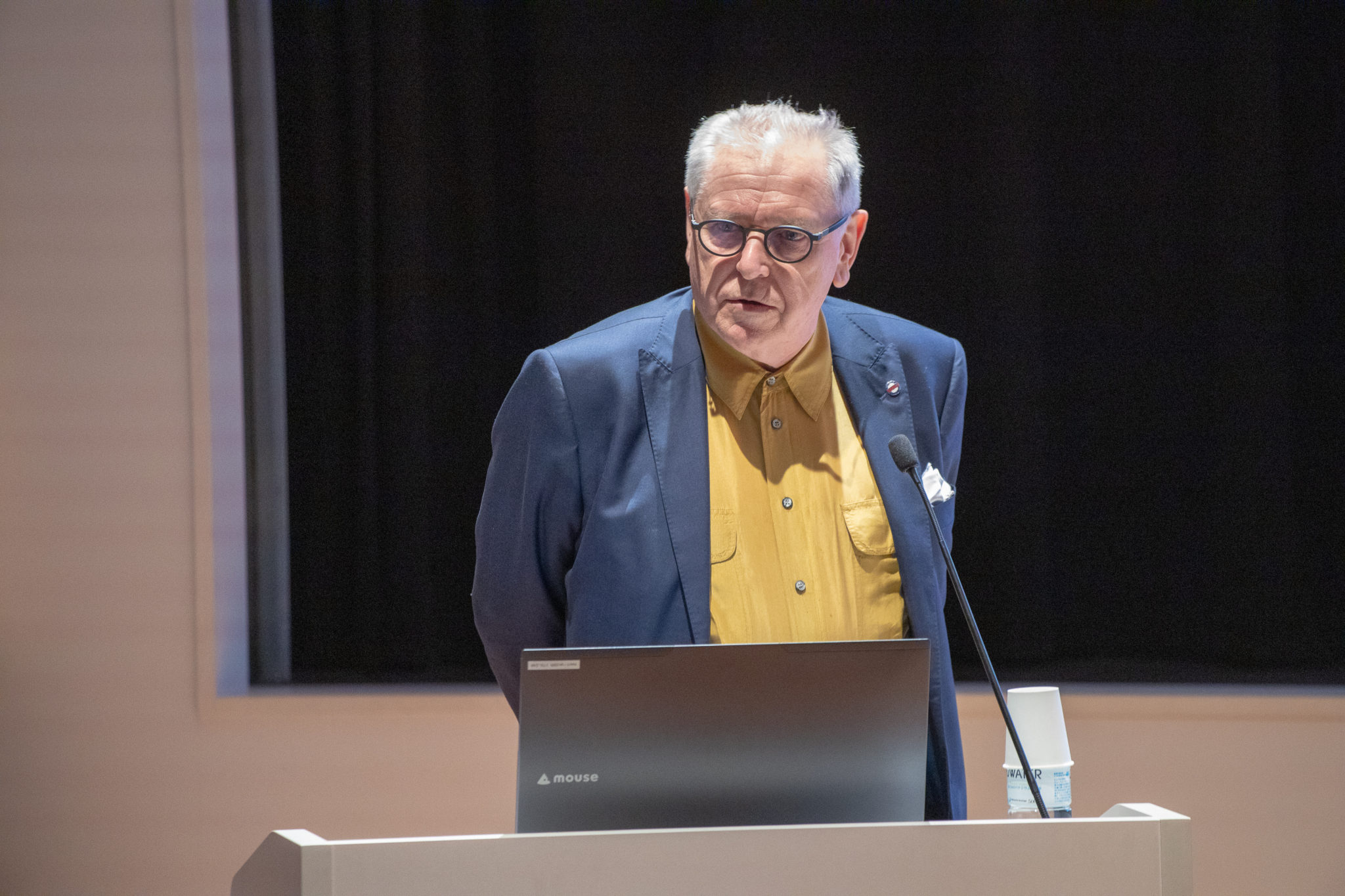Curator and coordinator. Lives and Works in Tokyo. Having worked as an assistant curator of Mori Art Museum, Tokyo (2001-9), she then moved to New Delhi India between 2009-18. While in India, she coordinated and researched for numerous projects. Worked as a project coordinator of Japan Foundation’s “Omnilogue: Journey to the West” at Lalit Kala Akademi, New Delhi in 2012, a research curator of Indian art for the Fukuoka Asian Art Triennale 2014, and coordinated to create a new video and painting installation of “The Returns of K.T.O.” by Japanese artist Tsuyoshi Ozawa for Yokohama Triennale 2017. Recent coordination is “Eiko Ishioka – Blood, Sweat , and Tears – A Life of Design ” at the Museum of Contemporary Art, Tokyo.
photo by Ujin Matsuo
Japan Contemporary Art Summit 2019
“Trans/National: Narrative of Contemporary Art after Globalization”
Open Keynote Lecture (2)
“Reconstruction, Transmission, and Stereotype: Three approaches towards contemporary Japanese Art.”
David Elliott (Deputy Director and Senior curator of Redtory Museum of Contemporary Art (RMCA), Guangzhou, China
In March 2019, the Japan Contemporary Art Summit 2019 invited national and international art professionals to a seminar entitled “Trans/National: Narratives of Contemporary Art after Globalization” that lasted over three consecutive days. These were a part of the Art Platform project created by the Agency of Cultural Affairs which aims to build a network and discuss Japanese contemporary art in a global context. (For the detail of this Summit, see Keynote Lecture (1) by Alexandra Munroe). At the closing program, British curator David Elliott delivered the second Keynote Lecture to the public.
Elliott started his curatorial career in 1970 and has been known as an active figure in contemporary art since then. Like Munroe, he has for many years researched Japanese modern and contemporary art. The show, “Reconstructions: Avant-garde Art in Japan 1945-65” at the Museum of Modern Art, Oxford in 1985 became the earliest survey show of Japanese modern and contemporary art in the West, to be followed by “Japon des avant-gardes,1910-1970” at the Centre Georges Pompidou, Paris in 1986, and Munroe’s “Japanese Art After 1945: Scream Against the Sky” at the Japan Society Gallery, New York in 1994. As the first director of the Mori Art Museum, Tokyo (2001-2006), he became a familiar figure in the Japanese art scene. This experience later prompted him to organize “Bye Bye, Kitty!!! Between Heaven and Hell in Contemporary Japanese Art” at the Japan Society Gallery in New York in 2011. He has worked as the director of numerous museums after twenty years’ work in Oxford; including Moderna Museet, Stockholm, the Mori Art Museum, Tokyo and the Istanbul Museum of Modern Art. Elliott is currently the deputy director and senior curator of the Redtory Museum of Contemporary Art (RMCA), Guangzhou, China and is finishing his new book, “Art and Trousers: Tradition and Modernity in Contemporary Asian Art” which will appear in 2020.
His lecture described how he encountered modern and contemporary art outside the UK and examined how, from the beginning of the 1980s, he has engaged with modern and contemporary art in a global field.
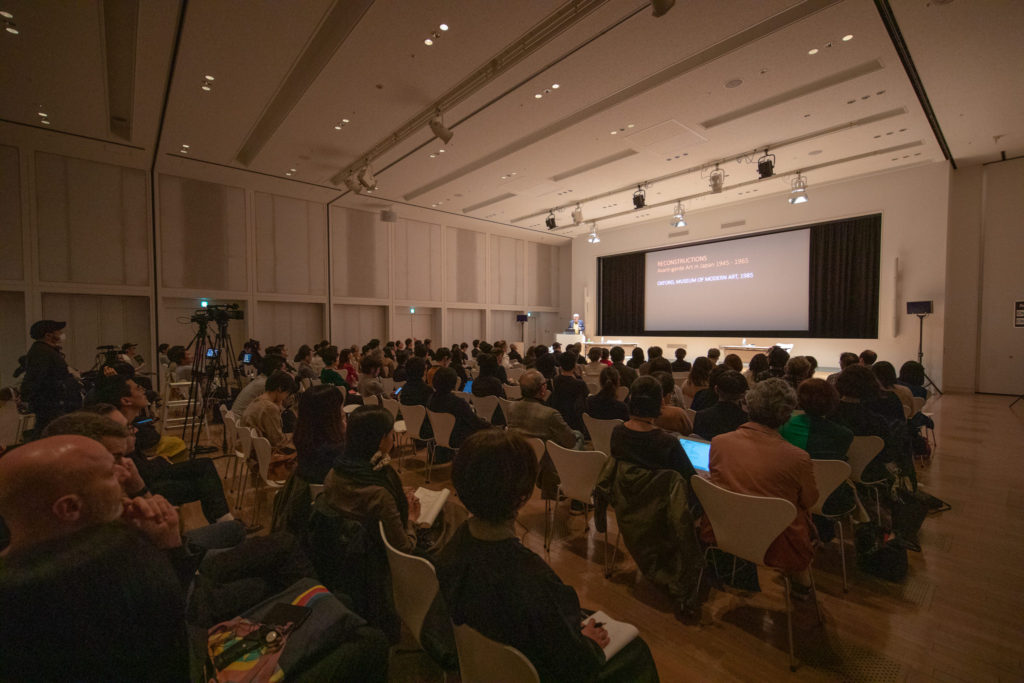
photo by Ujin Matsuo
1. Early 1970s: First Steps
Elliott got involved with art relatively early. While an undergraduate student in history at Durham University in the UK during the late 1960s, he had been wondering what to do with his life and tried in vain to make sense of the world. His interest in history was related to the nature of his generation: the first generation born in postwar Europe, the age of the Cold War.
His critical encounter with art outside his own culture happened on visits to Leicester Art Gallery and Museum which was near to where he went to school. The museum was well known for its collection of British art, particularly Sporting Painting, but in two galleries it had a very different collection of German Expressionism that had arrived there via Jewish emigrés who during the 1930s had fled Germany from the Nazis. These works were so different from British Art, quite unlike anything else he had seen, and his “discovery” of them provoked a kind of epiphany. They included, for instance, Lovis Corinth’s Symbolist “Portrait of Carl Ludwig Elias Aged 7 1/4” (1899) and Expressionist Ludwig Meidner’s “Apocalyptic Vision” (1912). Such works had been labelled as “degenerate” under Hitler’s dictatorship and had been destroyed, burned, or sold abroad. Elliott said that this experience opened his eyes to other kinds of art and made him think “If this was degeneracy, I wanted a slice of it.” In 1970, when he was an undergraduate student of history, at Durham, and inspired by an exhibition of Surrealism made by a friend. This led him to curate, “Germany in Ferment: Art and Society in Germany 1900-1937.” The exhibition focused on the development of modernism in German culture from the time of Impressionism to “Degenerate” art and also traveled to museums in Sheffield and Leicester.
2. Later 1970s:Museum of Modern Art, Oxford
When he was offered a first job at the Leicester Art Museum after graduation, Elliott was acutely aware that he didn’t know much about art as his major had been history. So he took further studies in Art History at Courtauld Institute of Art in London and then worked for just over two years at the Arts Council of Great Britain in London. In 1976, at the age of 27, he was offered the directorship of the Museum of Modern Art, Oxford.
Elliott was involved in both museum and academic practices, and remembers that contemporary art faced “a crisis” towards the end of the 1970s “when what we think of as ‘the age of the avant-garde’ came to an end.” American critic Lucy Lippard’s book “The Dematerialization of the Art Object” (1973) summarised this perfectly: “(in the Western world) art increasingly became less material, so as to almost ‘dematerialize’ itself out of existence.” This led to “a kind of implosion in a belief in the idea of a progressive ‘avant-garde’ as people waited for something else to happen.”
Under such conditions, Elliott curated numerous shows. A number of leading women artists such as Mary Kelly, Susan Hiller and Jo Baer were shown at this time. He then examined the early classical avant-garde through solo-exhibitions of Soviet artists El Lissitzky (1977) and Aleksandr Rodchenko (1979) as part of a “reconstruction of the history of the avant-garde in East-West Europe.” “The Falling Leaf: Aerial-Dropped Propaganda 1916-68” (1978) looked at the relationship between propaganda, advertising and art through the medium of small leaflets dropped out of planes. Many of these were from Asian conflicts during World War II and the Vietnam War.
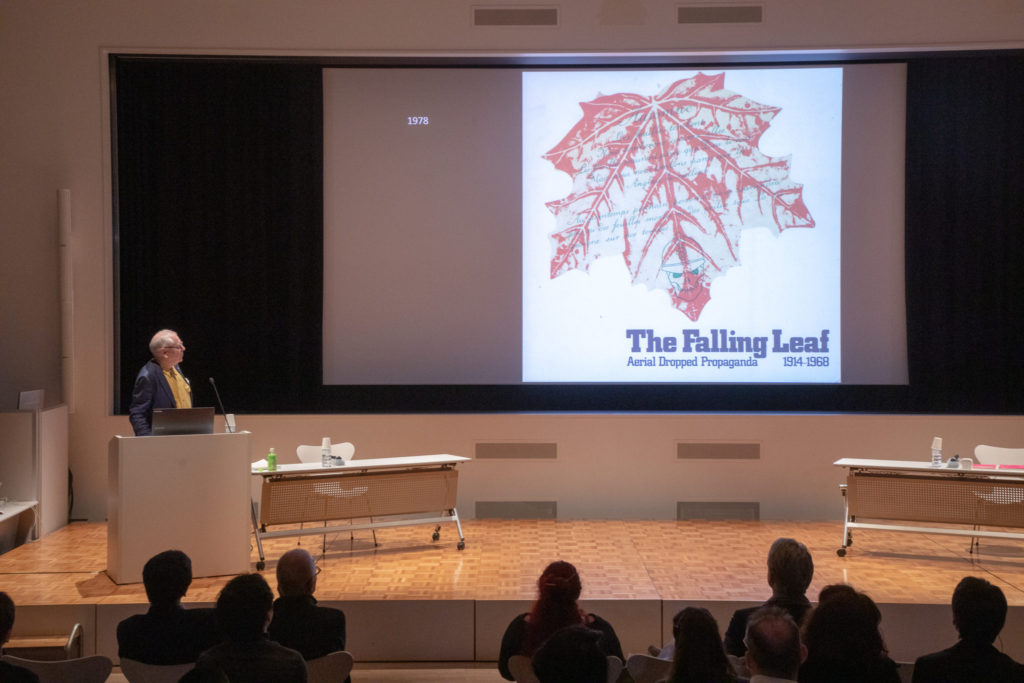
photo by Ujin Matsuo
3. 1980s 1: A Return to Painting
As part of the “implosion” in art history, and the rising desire for something new in response to the “dematerialization” of Minimalism and Conceptualism, the exhibition “A New Spirit in Painting” (1981) at the Royal Academy of Art, London was a milestone. The display of 38, largely male, figurative and abstract western painters indicated a return both to historicism and the medium of paint and this had a strong impact on the art market.
At the same time, US President Ronald Reagan and British Prime Minister Margaret Thatcherite came together as leaders of the “Free World” and indulged in an orgy of “Big Bang That cher ite Reaganomics.” The freeing of the money markets that this entailed had a vast impact on the art market as this “new spirit in politics” injected vast amounts of new wealth into the system. The expanding market in contemporary art was a perfect receptacle for new, sometimes suspect, money. Elliott recalls that “contemporary art, formerly a relatively modest concern, suddenly began to cost.”
In the midst of this increasingly market-oriented art scene, Elliott consistently began to organize exhibitions that insisted on a historical context as part of their viewpoint. “Twenty Years of Work,” (1982) was an accurate reconstruction of an exhibition that Russian futurist poet and artist Vladimir Mayakovsky had staged in Moscow and Leningrad in 1930 just before he committed suicide when under critical pressure from the newly restrictive mandate of Stalinism. This was a critical step for the end of the Avant-garde in the Soviet Union. A completely different show was of Jorg Immendorff’s “Café Deutschland” paintings (1982) that while being part of the “new spirit” of the late 1970s and ’80s also made Elliott’s audience aware of the oppressive undertow of power during the Cold War, an impression he reinforced through the exhibition “Tradition and Renewal: Contemporary Art from the GDR” (1984).
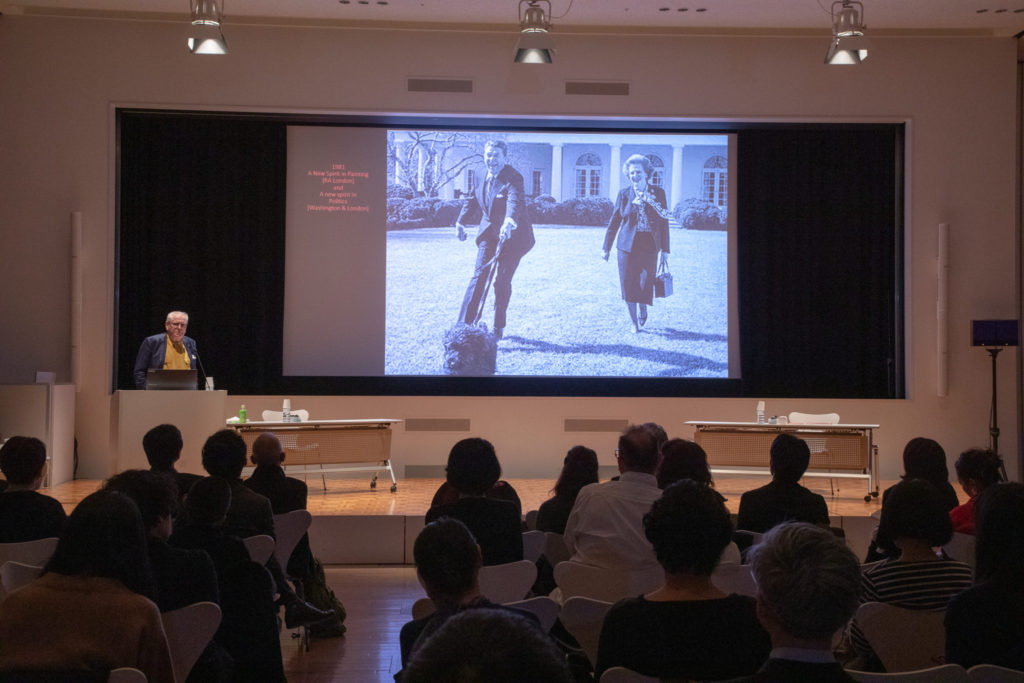
photo by Ujin Matsuo
4. 1980s II: An Encounter with Global Art
Elliott remembered that “ (…) with the end of the canonical idea of progressive movements forward, the whole idea of “avant-garde” suddenly evaporated and created a vacuum.” Curators who would have hated paintings in the 1970s suddenly started to look at nothing else and this seachange made him think about the fallibility of the criteria with which to view contemporary art in order to come to an opinion about whether it was any good. Decisions about quality in art, as in many other things, are a matter of comparison. The art world now began to seem a rather small place as it was obviously mainly run by white males who happened to live in western Europe or the USA. He began to realise that contemporary art worth considering must surely be much larger than this.
In 1982, he grasped an opportunity to organize a series of exhibitions about modern and contemporary art and culture in India. “India, Myth and Reality: Aspects of Modern Indian Art” showed the work of members of the Bombay Progressive Artists’ Group (set up in 1947 immediately after Independence from the British Empire) to the youngest generation. “Gods of the Byways (from Rajasthan and Himachal Pradhesh)” examined aspects of folk art in an equal way. “The Other India: Seven Contemporary Photographers” lighted on the different approaches of photographers across the sub-continent; from those who meditated on the melancholy decay of temples in the South to those who documented the tragic drug addictions of western hippies. He learnt about Indian art quickly, both through direct experience of visiting and talking with artists and the examples of Ebrahim Alkazi, former principal of the National School of Drama and a leading advocate of contemporary Indian art and Victor Musgrave who, since the late 1950s, had shown it in his London gallery. About this, Elliott recalls: “I had crossed a barrier. The obvious quality of the works in these exhibitions pushed me to look further afield.”
5. Reconstruction: Avant-garde Art in Japan 1945-65
After Southern Asia, his next focus moved further East: Japan. In the West, people knew a little about Gutai but not much else. He asked colleagues in Oxford if anyone knew anything more about this and one of them mentioned Kazu Kaido who was completing a doctoral thesis on post-war Japanese Art at the university. When she showed him the work in which she was interested, he was “absolutely stunned” by what he saw. This experience moved him to collaborate with her in curating “Reconstructions: Avant-garde Art in Japan 1945-65” in 1985.
The exhibition consisted of 36 artists, including four women. Although these works were not in the exhibition, the exhibition catalogue started with an image of Kenichi Nakamura’s war painting “Landing Operation, battle of Kota Baru” (1941) followed by Koyo Ishikawa’s photo documentation “Tokyo Ruins after Aerial Bombing 10th, March, 1945.” In this way Japanese experiences of World War II were expressed to a British audience some of whom doubted whether any kind of culture existed at that time.
The exhibition not only focused on the difficulties and conflicts of actual post-war reconstruction but also examined a period of avant-garde history that had been neglected in Japan itself. It was introduced by the realist painting of a pile of corpses in “Defeated in Battle” (1948) by Ichiro Fukasawa opposite the surrealist “Demonic Music” (1948) by Iwami Furusawa, a red painting showing ruins dwarfed by a giant female devil and a vast atomic mushroom cloud. The exhibition was accompanied by two others: “Black Sun: The Eyes of Four. Roots and Innovation in Japanese Photography” (1985) curated by Mark Holborn, with photographs by Eiko Hosoi, Shomei Tomatsu, Masahisa Fukase and Daido Moriyama, and “Dada in Japan 1920 to 1970,” a modest documentary show put together by artist Yoshio Shirakawa that had been first shown at the Kunstmuseum Dusseldorf in Germany. There were also supporting programmes of feature and documentary films and lectures.
Regarding Taro Okamoto’s surrealistic painting “The Law of the Jungle” (1950), a reference to the Red Purges in Tokyo which were then at their height, Elliott remarked “I was very lucky in the research with Kazu Kaido, I visited Japan on three occasions to meet and get to know the artists and through this ‘crash course’ began to appreciate the quality and complexity of post-war Japanese art.” He remembered how reportage painter Kikuji Yamashita came to his gallery with his painting: “‘The Tale of Akebono Village’ (1953) was not then in a museum collection because his work was not yet highly valued by the Japanese. In fact, the avant-garde in Japan between 1945 to 1965 was not then recognized as a unit or period in Japanese art history but was split up into different individual groups.”
In a specifically Japanese version of surrealism, On Kawara’s figurative paintings “Bathroom (Pregnant Woman)” (1954) and “Black Soldier” (1955), along with Shigeo Ishii’s “Violence Series: Pleasure” (1957) and Hiroshi Nakamura’s “Metropolis in Revolution” (1959) all expressed resistance to American cultural influence as well as the ressurgent authoritarianism of the state.
Art from the 1960s was represented by the Neo-Dada Organizers’ documentations of “Action in Ginza, Tokyo in 1960” and also by the works and “Event” performances of Hi-Red Center (Jiro Takamatsu, Natsuyuki Nakanishi, Genpei Akasegawa). Elliott said that “Their amazing performances were ‘punk’. Punk before the fact. I think truly that between 1960 to 1965, the most vibrant, energetic cities in the world for new art were Tokyo, Buenos Aires and New York. In these cities artists were out on the street.” Other artists from the 1950s and ’60s that were shown included Mokuma Kikuhata of Kyushu-ha, Yayoi Kusama, Hisao Domoto, Toshimitsu Imai, Shusaku Arakawa, Kumi Sugai and artists from Gutai.
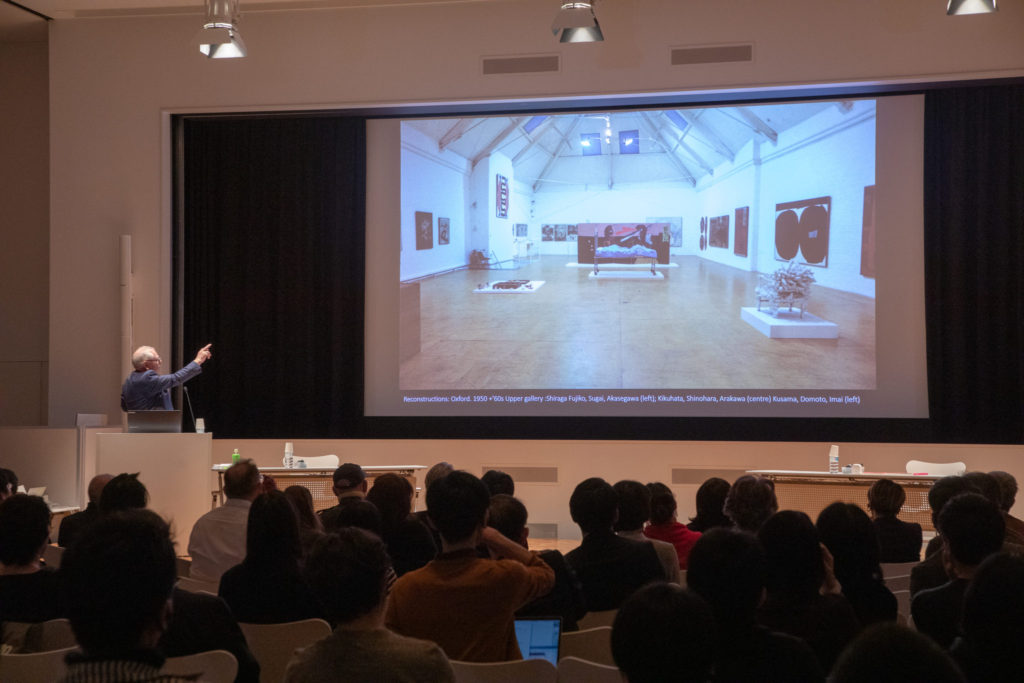
photo by Ujin Matsuo
6. Transmissions: A tale of Two cities
In “Tokyo-Berlin/Berlin-Tokyo: Continuing Dialogues of Modern Cities” (2007) at the Mori Art Museum, Tokyo, Elliott focused on cultural links between the newly built capitals, of Berlin and Tokyo from the middle of the nineteenth century to the present. Comparing the two urban cultures through art, architecture, painting, photography, design in their social and political context, Elliott invited the viewer to consider to what extent artists, architects, and designers of both cities had inspired each other over 150 years of cultural transmission.
There had been many cultural cross overs between Tokyo and Berlin at the turn of the century. For example, in architecture, German Architects Ende & Böckman built the Ministry of Justice in a western Gründerzeit style, which still stands in Tokyo, while Hermann Muthesius, who later led the Deutsche Werkbund (DWB), designed there the German protestant church. Back in Berlin, staff from Ende and Böckmann’s office employed the style of Japonaiserie in new buildings for the Zoo. The main building was destroyed in World War II, but the Elephant Gate still remains.
While the institutional German style seemed appropriate for government and public architecture in Tokyo, traditional Japanese culture – or contemporary versions of it in the form of Japonism – inspired Berliners. Kawakami’s performance company was executing a world tour at that time and Sada Yakko, an actress of the company, fascinated people throughout Europe – in particular the Berlin artist Max Slevogt who painted her a number of times. Ernst Ludwig Kirchner, a leading member of the Expressionist group Die Brücke, was also fascinated by images of kabuki, geisha, and shunga and depicted them in his paintings.
Just before the outbreak of World War 1, composer Kosaku Yamada and designer Kazou Saito, who had been studying in Berlin, brought an avant-garde show of work from Der Stürm Gallery to Tokyo. Since 1910, Der Stürm had been one of the city’s leading galleries for new art and also published a bimonthly magazine on new art and literature. This show opened in March 1914 and featured Oskar Kokoschka’s “Murder Hope of Women” drawings as well as drawings and woodcuts by Franz Marc and other leading expressionists. This exhibition was the first to show original prints and drawings of European modernist artists in Tokyo. Young Japanese artists, such as Gyo Fumon, Koshiro Onchi and Kiyoshi Hasegawa were strongly inspired by both the German Expressionists and Italian Futurists who were shown in this exhibition. But even before this, books on German art and the magazine of the Stürm gallery had already made a strong impact in Japan: in 1912 Tetsugoro Yorozu had written in German “Selbstbildnis” (self-portrait) on the back of his “Self-portrait with red eyes.”
Soon after World War I, the strong link with the Berlin avant-garde was reforged through engagements with Dada by Tomoyoshi Murayama, Yoshimitsu Nagano and Tomoo Wadachi young artists and writers who were living there. On return to Tokyo, Murayama founded the Dadaist MAVO group that published a regular journal and combined artworks with performances and actions. [Elliott also discussed the impact of the Bauhaus on art and design in both cities, the “Dark Years” of the 1930s and early 1940s that marked the coeval rise of militarism in Japan and of Nazism in Germany, and the period of reconstruction of both cities after World War II].
This exhibition also traveled to Berlin to be shown by its co-organisers at the Neue Nationalgalerie, which had been designed by Mies van der Rohe and was an exhibit in its own right. Only the section of contemporary art had changed: in Berlin, the German curators had selected contemporary Japanese artists, architects and designers, while the Japanese team showed contemporary artists from Berlin.
Elliott summarised this project as follows: “This exhibition was not merely a cultural conversation between two cities that highlighted similarities and differences, but it also tracked a difficult, at times tragic, story about the development of modernity across the world that has touched us all. In the process it has unearthed a more complex history of cultural exchange that has been previously acknowledged and has also challenged the myth of hegemonic Parisian cultural influence which had previously been the prevailing art historical view of how modernism entered Japanese art.”
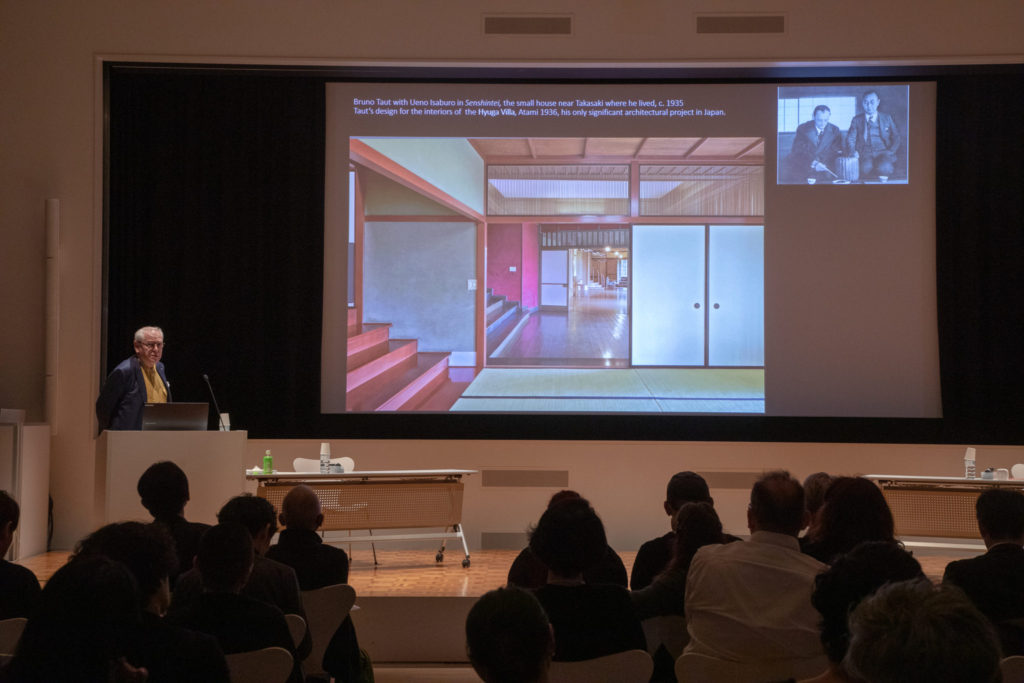
photo by Ujin Matsuo
7. Stereotypes: Bye Bye Kitty!!! – Farewell to the Pretty World
The exhibition “Bye Bye Kitty!!!: Between Heaven and Hell in Japanese Contemporary Art” (2011) focused on stereotypes of Japanese culture today and how they were understood both inside Japan and abroad. Referring to the character of “Hello Kitty,” pioneered by Sanrio as a quintessential kawaii figure, this exhibition was a response to Takashi Murakami’s previous exhibition “Little Boy; the Arts of Japan’s Exploding Sub-Culture,” (2006) that had surveyed the significance of Otaku culture and was also shown in the Japan Society Gallery in New York. Murakami’s subtext, however, was that the image of infantilism throughout Japanese society and politics related to the constitutional embargo on Japanese rearmament after World War II. The title of his exhibition echoed the name given to the Atomic Bomb that the US had dropped on Hiroshima in 1945.
Elliott felt that Murakami’s claim that infantilism was inevitably a product of Japan being unable to protect itself was a simplification of both contemporary Japanese culture and of the phenomenon of otaku. “There is a serious self-critical culture in Japan,” he said, “there are people who are not only thinking critically about themselves and their own society, but also about their place in the world at large. ‘Bye-Bye Kitty’ is against the stereotypical kawaii view of Japanese culture and implies its subversion. Inevitably, the language of kawaii may be used sardonically by artists to achieve this subversion.”
The exhibition consisted of sixteen artists born from the 1960s to the 1980s: Yoshitomo Nara, Makoto Aida, Miwa Yanagi, Kohei Nawa, Chiharu Shiota, and others working in a wide range of media: painting, sculpture, installation, video, and photographs. This diverse group all critically examined contemporary social and cultural conditions in Japan. Some did this by riffing on techniques of traditional Japanese painting or of modernity as in Aida’s series “War painting RETURNS” and in the piled dead bodies of salarymen in the “traditional” style of sansuiga (paintings of mountains and water) in his vast painting “Ash Coloured Mountain.” These were set against Miwa Yanagi’s “feminist”, photographic images of angry, potent “Windswept Women” and her “Grandmother” series of works that in a reversal of youth against age completely undermined the image of the subservient, obedient Japanese woman. The works in the exhibition were grouped around three core ideas: Critical Memory, Threatened Nature, and the Unquiet Dream.
The exhibition presented an alternative view of recent decades of Japanese contemporary art that focused on the reanimation of traditional Japanese sensibilities through new means. It aimed to show a sophisticated, nuanced, deeply human concern for art (and life) which could be seen in contrast to both foreign and Japanese obsessions with the mass media languages of otaku, anime and manga. [Incidentally, the exhibition created great interest in New York as it opened just after the Great Tohoku earthquake. This heightened a sense of concern about the wider context of Japanese culture, society and politics.]
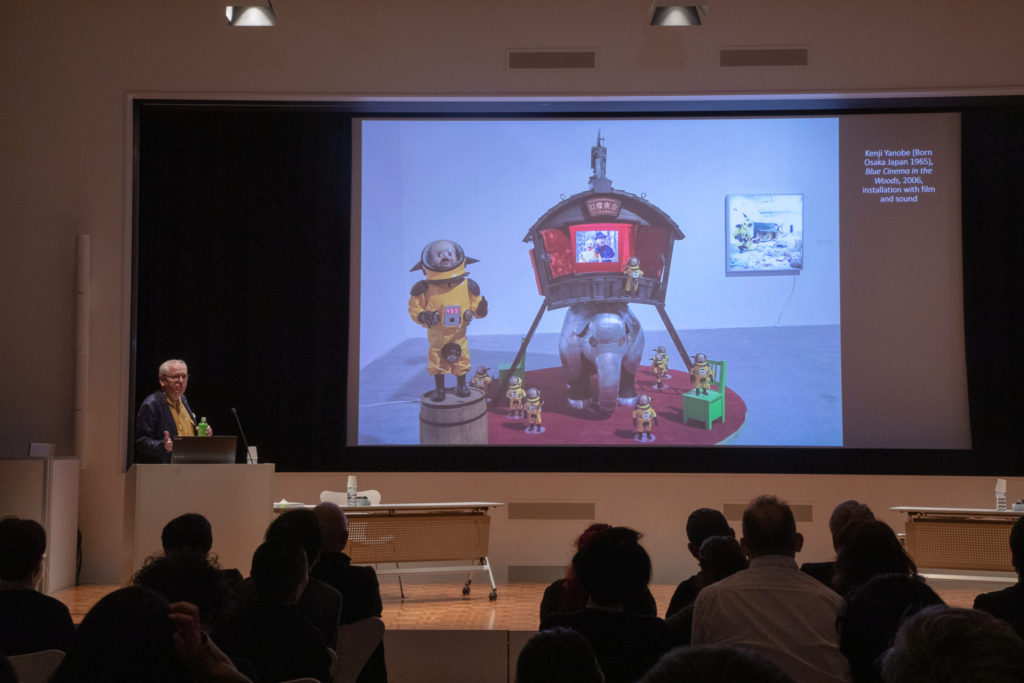
photo by Ujin Matsuo
This keynote lecture presented Elliott’s continuing exploration of art outside his country of origin and his various approaches to the consolidation of a global, decolonised history that had grown out of his early encounter with “degenerate” German modern art. The source of his interest in post-war history synchronizes with his background, having been born just after the end of the World War II. Following his footsteps chronologically, the audience learned how he kept questioning Eurocentric perspectives, and candidly introduced alternative possibilities to this by focusing on different ideas about and traditions of aesthetic quality in showing art outside the western mainstream. The lecture inspired us to think of the ways in which global art, including Japanese art, can possibly be presented to audiences throughout the world today.
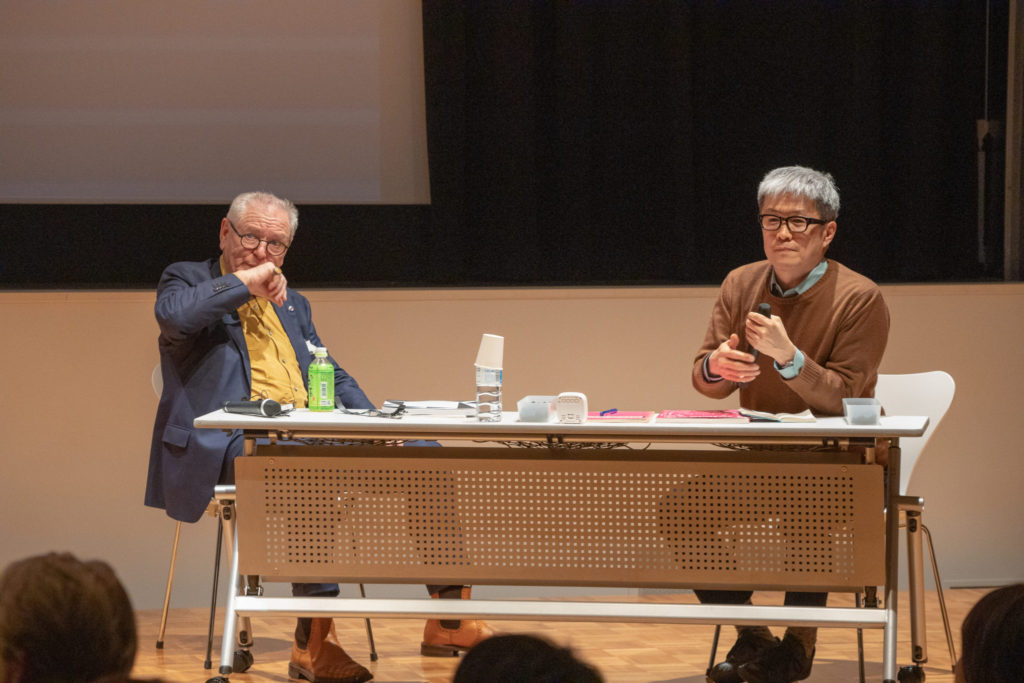
photo by Ujin Matsuo
David Elliott:
British art historian, curator, writer and teacher who has directed museums in Oxford (MoMA 1976-1996), Stockholm (Moderna Museet, 1996-2001), Tokyo (Mori Art Museum, founding director 2001-2006), and Istanbul (Museum of Modern Art, 2007). He is currently Vice Director and Senior Curator at the Redtory Museum of Contemporary Art (RMCA) and Arts District in Guangzhou (at 2019) and chairman of the Advisory Board of MOMENTUM in Berlin. A specialist in Soviet and Russian avant-garde, as well as in modern and contemporary Asian art, he has published widely in these fields as well as on many other aspects of contemporary art. In 2008-10 he was Artistic Director of The Beauty of Distance: songs of survival in a precarious age, the 17th Biennale of Sydney; in 2011-12 he directed The Best of Times, The Worst of Times: rebirth and apocalypse in contemporary art, the inaugural International Biennale of Contemporary Art in Kyiv; from 2012 to 2014 he was Artistic Director of A Time for Dreams, the IV International Moscow Biennale of Young Art; and from 2014 to 2016 he was Artistic Director of The Pleasure of Love, the 56th October Salon in Belgrade. Art and Trousers: Tradition and Modernity in Contemporary Asian Art, his new book, will be published by ArtAsiaPacific, Hong Kong/London in 2019.
INFORMATION
Bunkacho Art Platform Japan Bunkacho Art Platform Japan
Japan Contemporary Art Summit 2019
Trans/National: Narrating Contemporary Art after Globalization
Keynote Lecture (2) Lecture by David Elliott (Vice-Director and Senior Curator, Redtory Museum of Contemporary Art (RMCA), Guangzhou) Moderator: Michio Hayashi (Professor, Faculty of Liberal Arts, Sophia University) Date : March 21, 2019 Venue: The National Art Center Tokyo Organized: Agency for Cultural Affairs, Japan (Bunkacho)


